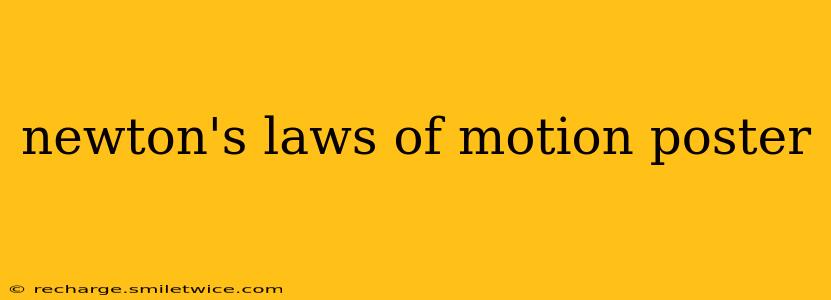Sir Isaac Newton's three laws of motion are fundamental principles in classical mechanics, forming the basis for understanding how objects move. This poster-worthy guide will break down each law, providing clear explanations, real-world examples, and answers to frequently asked questions.
Newton's First Law of Motion: The Law of Inertia
Statement: An object at rest stays at rest and an object in motion stays in motion with the same speed and in the same direction unless acted upon by an unbalanced force.
This law essentially describes inertia – the tendency of an object to resist changes in its state of motion. Think about it: a hockey puck on frictionless ice will continue sliding indefinitely at a constant speed and direction unless something – like a hockey stick or the boards – acts upon it.
Real-world examples:
- A book resting on a table: The book remains at rest because the forces acting on it (gravity and the table's upward force) are balanced.
- A car suddenly stopping: Your body continues moving forward until your seatbelt or the dashboard applies a force to stop you. This is why seatbelts are crucial for safety!
- A space shuttle in orbit: Once it reaches a certain speed, it continues orbiting Earth because there's minimal friction in space.
Newton's Second Law of Motion: F=ma
Statement: The acceleration of an object is directly proportional to the net force acting on the object, is in the same direction as the net force, and is inversely proportional to the mass of the object.
This is often expressed as the famous equation: F = ma, where:
- F represents the net force (in Newtons)
- m represents the mass of the object (in kilograms)
- a represents the acceleration of the object (in meters per second squared)
This law shows that a larger force will result in a greater acceleration, while a larger mass will result in a smaller acceleration for the same force.
Real-world examples:
- Pushing a shopping cart: The harder you push (greater force), the faster it accelerates. A heavier cart (greater mass) will accelerate more slowly than a lighter one with the same force applied.
- Kicking a soccer ball: A harder kick (greater force) results in a faster kick (greater acceleration).
- Launching a rocket: The enormous force from the rocket engines overcomes the rocket's massive mass, producing the acceleration needed to overcome Earth's gravity.
Newton's Third Law of Motion: Action and Reaction
Statement: For every action, there is an equal and opposite reaction.
This means that whenever one object exerts a force on a second object, the second object simultaneously exerts a force equal in magnitude and opposite in direction on the first object. These forces are called action and reaction forces. It's crucial to remember that these forces act on different objects.
Real-world examples:
- Walking: You push backward on the ground (action), and the ground pushes forward on you (reaction), propelling you forward.
- Swimming: You push backward on the water (action), and the water pushes forward on you (reaction), allowing you to move through the water.
- Rocket propulsion: The rocket expels hot gas downward (action), and the gas exerts an upward force on the rocket (reaction), causing it to lift off.
Frequently Asked Questions
What is inertia?
Inertia is the tendency of an object to resist changes in its state of motion. An object at rest tends to stay at rest, and an object in motion tends to stay in motion at the same speed and in the same direction unless acted upon by an unbalanced force.
How does Newton's Second Law relate to momentum?
Newton's Second Law is closely related to the concept of momentum (p = mv). The change in momentum of an object is equal to the net force acting on it multiplied by the time interval during which the force acts (Impulse).
What are some real-world applications of Newton's Laws?
Newton's Laws are fundamental to countless applications in engineering, physics, and everyday life, including designing vehicles, bridges, and aircraft, understanding projectile motion, and explaining celestial mechanics.
This comprehensive guide provides a solid understanding of Newton's Laws of Motion. By understanding these fundamental principles, you can better understand the world around you and the mechanics of movement. Remember to always consider the context and the forces acting on objects when applying these laws.
